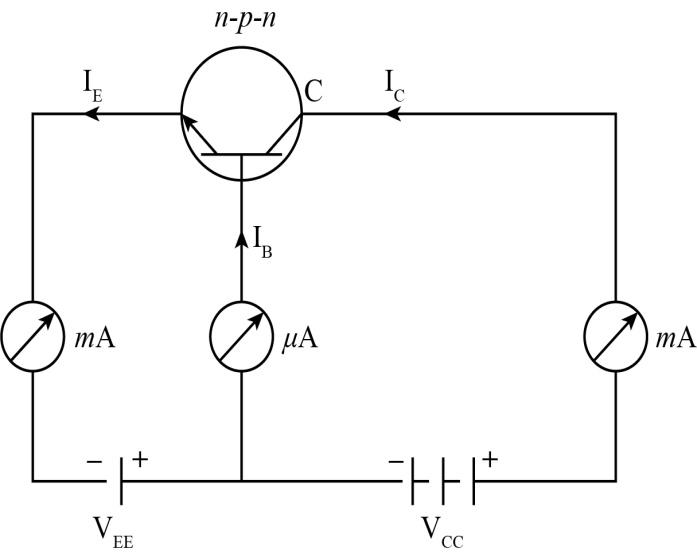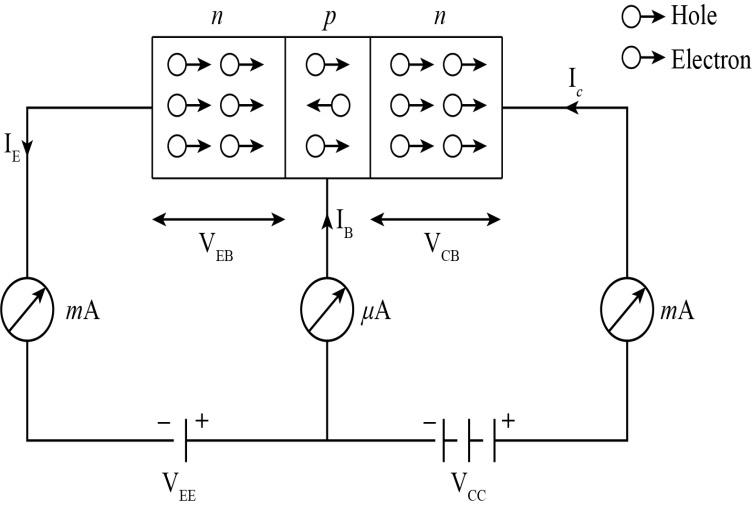
Draw a circuit diagram of the n-p-n transistor with its emitter- base junction forward biased and base-collector junction reverse biased. Briefly describe it’s working. Explain how a transistor in the active states exhibits low resistance at its emitter based junction and high resistance at its base-collector junction.
Answer
569.7k+ views
Hint: To describe its working first of all we know about transistor and its types or it has three terminals i.e. base, emitter, and collector.
Complete Step-by-step Solution
Diagram of the n-p-n transistor.

Working of n-p-n transistor:

In above figure voltage across emitter- base junction is ( ${V_{EB}}$) and the voltage across collector-base junction is (${V_{CB}}$).
The emitter-base junction of the n-p-n transistor is forward biased with the power supply$({V_{EE}})$, whereas the collector base junction is reversed biased with the power supply $({V_{CC}})$. When an emitter-base junction is forward biased, electrons majority carriers in the emitter are repelled by the negative terminal of the power supply towards the base. The barrier potential of the emitter-base junction decreases and the electrons enter the base. About 5% of these electrons combine with the holes i.e. ${I_B}$ small base current. The remaining electrons enter the collector region because they are attracted to the positive terminal battery $({V_{CC}})$ as shown in the above figure and the electron from the negative terminal of the battery $({V_{EE}})$ enters the emitter region. Thus continuous current flows emitter to the collector through the base regions.
Therefore equation becomes (${I_E} = {I_B} + {I_C}$ )
Transistors are nonlinear devices. They have four distinct modes of operation. They are:
Saturation: The transistor acts like a short circuit. Current flows from collector to emitter.
Cut-off: The transistor acts like an open circuit. No current flows from collector to emitter.
Active: Current flows from collector to emitter and current are proportional to the current flowing into the base.
Reverse active: Current is proportional to the base current but it flows in the reverse direction. The flow of current is from emitter to collector.
A transistor is said to be in its active mode if it is operating between saturated and cut-off mode. In the active mode of the transistor, the emitter-base junction is forward biased, and collector base junction is reversed biased. When a transistor operates during this mode, the collector current increases linearly with the rise in base current. That’s why in the active state it exhibits low resistance at the emitter-base and high resistance at its base-collector.
Note:
The p-n-p transistor working is opposite to the n-p-n working. The flow of current in the n-p-n transistor is from collector to emitter since positive supply is given to the base but in a p-n-p transistor, the flow of current is from emitter to collector. A transistor is operating in an active mode when it is operating between cutoff mode and saturation mode.
Complete Step-by-step Solution
Diagram of the n-p-n transistor.

Working of n-p-n transistor:

In above figure voltage across emitter- base junction is ( ${V_{EB}}$) and the voltage across collector-base junction is (${V_{CB}}$).
The emitter-base junction of the n-p-n transistor is forward biased with the power supply$({V_{EE}})$, whereas the collector base junction is reversed biased with the power supply $({V_{CC}})$. When an emitter-base junction is forward biased, electrons majority carriers in the emitter are repelled by the negative terminal of the power supply towards the base. The barrier potential of the emitter-base junction decreases and the electrons enter the base. About 5% of these electrons combine with the holes i.e. ${I_B}$ small base current. The remaining electrons enter the collector region because they are attracted to the positive terminal battery $({V_{CC}})$ as shown in the above figure and the electron from the negative terminal of the battery $({V_{EE}})$ enters the emitter region. Thus continuous current flows emitter to the collector through the base regions.
Therefore equation becomes (${I_E} = {I_B} + {I_C}$ )
Transistors are nonlinear devices. They have four distinct modes of operation. They are:
Saturation: The transistor acts like a short circuit. Current flows from collector to emitter.
Cut-off: The transistor acts like an open circuit. No current flows from collector to emitter.
Active: Current flows from collector to emitter and current are proportional to the current flowing into the base.
Reverse active: Current is proportional to the base current but it flows in the reverse direction. The flow of current is from emitter to collector.
A transistor is said to be in its active mode if it is operating between saturated and cut-off mode. In the active mode of the transistor, the emitter-base junction is forward biased, and collector base junction is reversed biased. When a transistor operates during this mode, the collector current increases linearly with the rise in base current. That’s why in the active state it exhibits low resistance at the emitter-base and high resistance at its base-collector.
Note:
The p-n-p transistor working is opposite to the n-p-n working. The flow of current in the n-p-n transistor is from collector to emitter since positive supply is given to the base but in a p-n-p transistor, the flow of current is from emitter to collector. A transistor is operating in an active mode when it is operating between cutoff mode and saturation mode.
Recently Updated Pages
Master Class 12 Business Studies: Engaging Questions & Answers for Success

Master Class 12 Economics: Engaging Questions & Answers for Success

Master Class 12 English: Engaging Questions & Answers for Success

Master Class 12 Maths: Engaging Questions & Answers for Success

Master Class 12 Social Science: Engaging Questions & Answers for Success

Master Class 12 Chemistry: Engaging Questions & Answers for Success

Trending doubts
What are the major means of transport Explain each class 12 social science CBSE

Which are the Top 10 Largest Countries of the World?

Draw a labelled sketch of the human eye class 12 physics CBSE

How much time does it take to bleed after eating p class 12 biology CBSE

Explain sex determination in humans with line diag class 12 biology CBSE

Differentiate between homogeneous and heterogeneous class 12 chemistry CBSE




